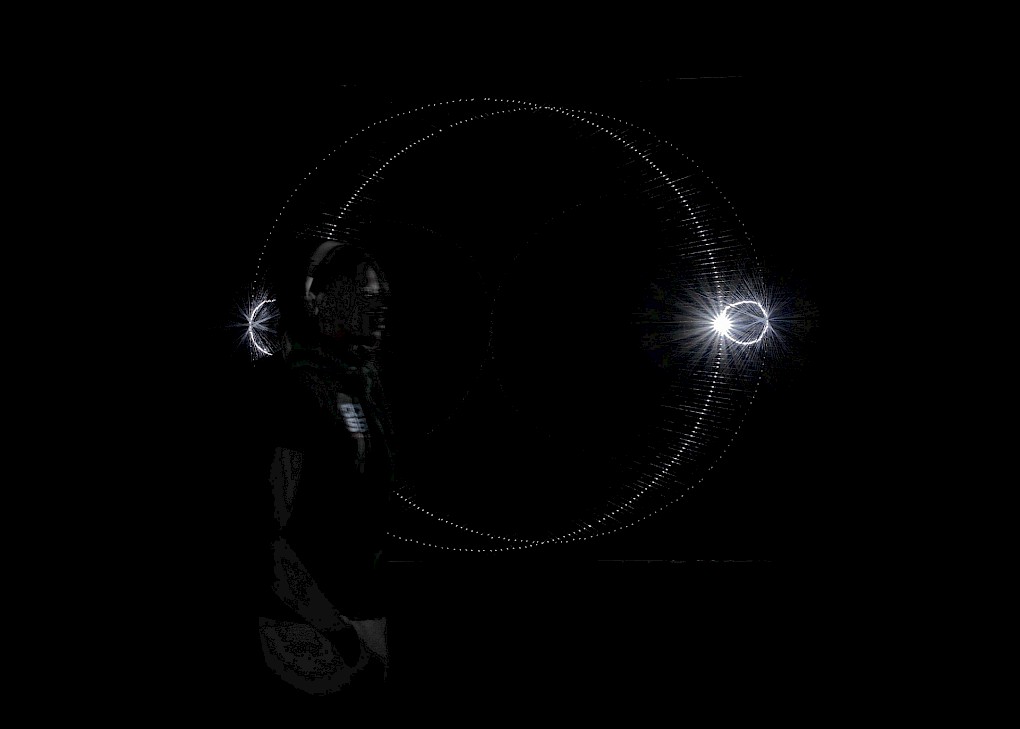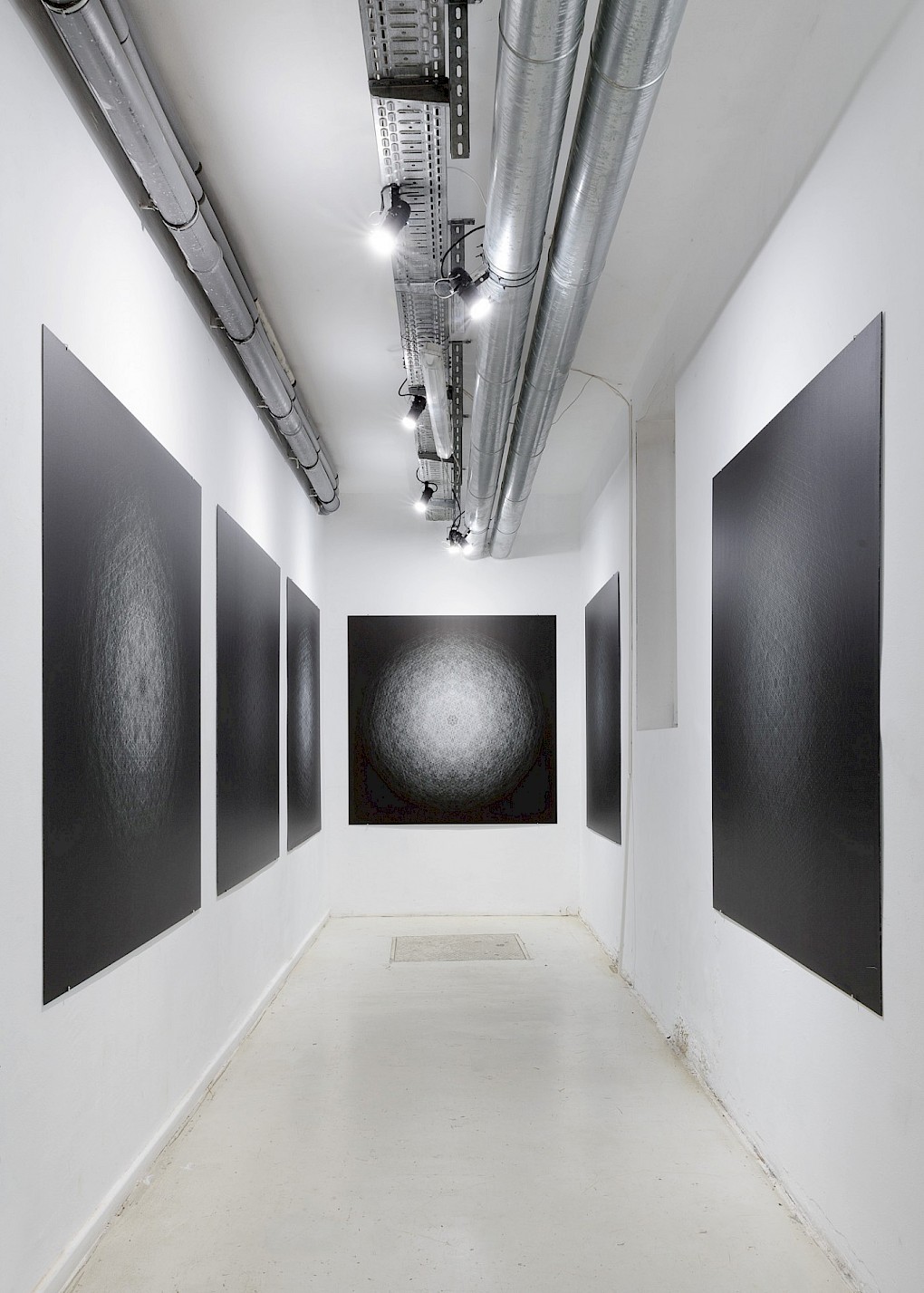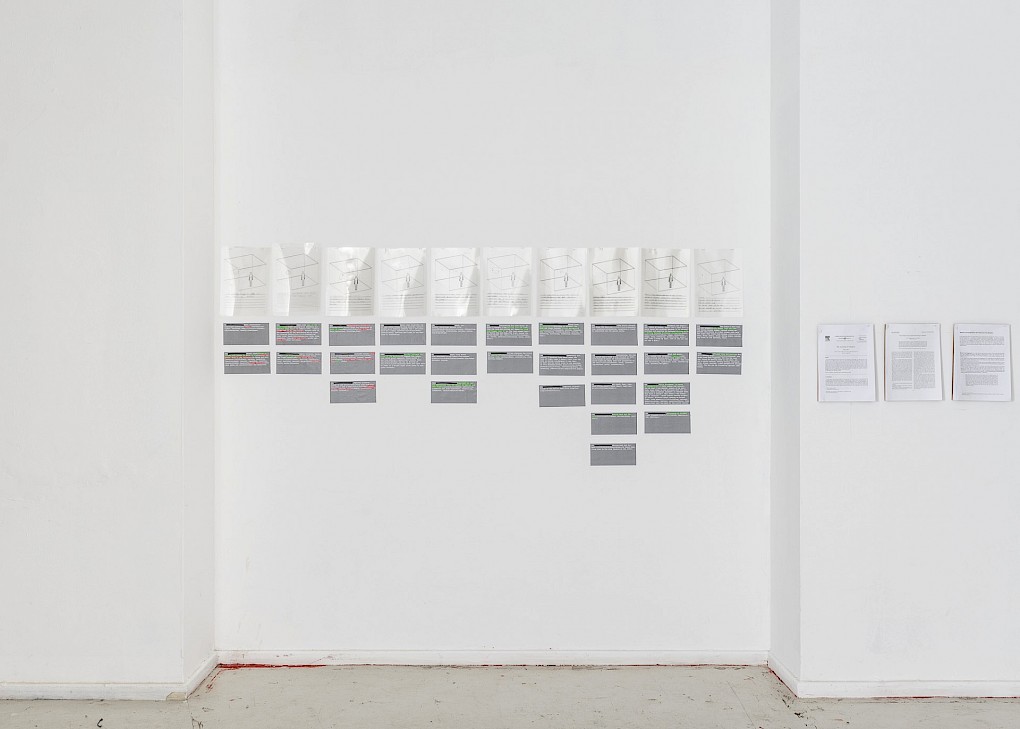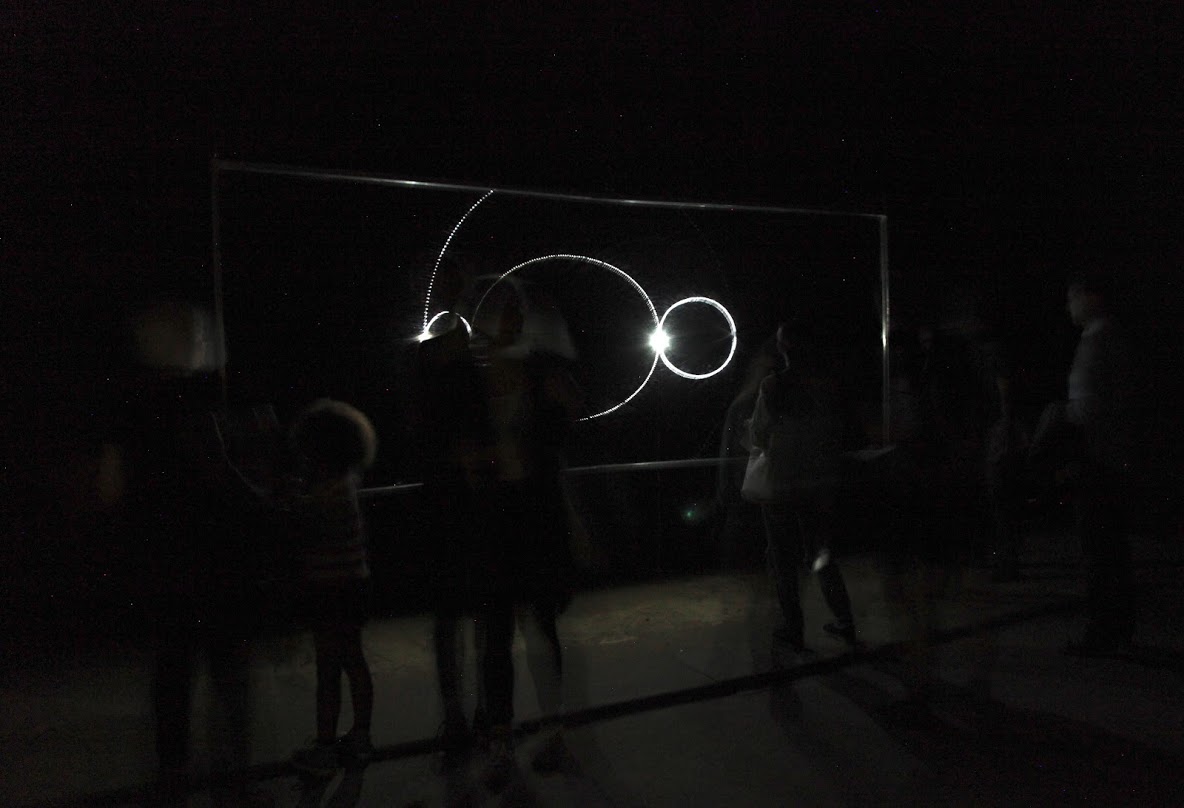Your Country Of Two Dimensions Is Not Spacious Enough.
LIMITS OF PERCEPTION LAB

By Ivana Franke
OPEN LAB, EXHIBITION, EXPERIMENTS Extended until 05.07.2020 Tuesday–Sunday 14:00–19:00
Open to the public (max of 15 people in the gallery at same time).
Entrance Please use our entrance in Plantagenstraße 31
ONLINE INVOCATIONS 21.06.2020 18:00
WITH Taita Juan Martín Jamioy Juajibio, Juan-Andres Leon, Sangeetha Menon, Ida Momennejad, Monica Narula, Arlette Ndakoze, Sunčica Ostojić, Lisa Randall, Tomas Saraceno, Elisabeth Tambwe & the LAB Team
SATELLITE EVENT: DREAMSCAPE #1 Extended until 05.07.2020
WITH Israel Lopez
In the Limits Lab in Berlin-Moabit – Open to the public by appointment, at: https://dreamscape1.as.me/
WARNINg Strobe lights are used during this exhibition which might trigger seizures and distort vision.
///\\\///\\\///\\\///\\\///\\\///\\\///\\\///\\\///\\\///\\\//////\\\///\\\///
We kindly ask you to:
/\ Wear a mask
/\ Leave your bag at the entrance
/\ Immediately wash your hands upon entry
/\ Fill out the registration form that we are obliged to keep
/\ Keep a distance of 1,5m to others in the space
/\ Wait outside if there are more than 15 people inside or the SAVVY person in charge asks you to
///\\\///\\\///\\\///\\\///\\\///\\\///\\\///\\\///\\\///\\\//////\\\///\\\///
...your country of Two Dimensions is not spacious enough to represent me, a being of Three, but can only exhibit a slice or section of me, which is what you call a Circle.
At this moment of being confined to enclosed, often small spaces, and fixed in particular locations, our thoughts are frequently turning inwards, and we are reconsidering relations of external, internal, geographic, and mental spaces.
LIMITS OF PERCEPTION LAB invites us to extend the solitary experience of locatedness to extra dimensions, where “groundlessness,” [1] as Francisco Varela puts it, presents us with a possibility for mental expansion in multiple directions.
For one week, SAVVY Contemporary transforms itself into the LIMITS OF PERCEPTION LAB, a hybrid of an artist studio and a scientific laboratory, using multidisciplinary methodologies to study experience and as a means of knowledge disruption and production. [2] It is grounded in artistic practice within an extended context, drawing from and working with practitioners from the fields of cognitive and vision science, neuroscience, experimental psychology, mathematics and architecture while being in conversation with critical practitioners from the fields of humanities, including but not limited to art history, history of science, and philosophy.
The project serves an experimental phase of a long-term platform for investigation of perceptual limits as potential sites of social transformation. This materialization of the open lab at SAVVY Contemporary focuses on perception and imagination of extra dimensions.
In this context, the SAVVY Contemporary iteration of LIMITS OF PERCEPTION LAB concerns itself with limits of perception and epistemological categories, including the Western definitions, and how they shape the ways in which we are taught to think, feel, and rationalise our sensing of ourselves and the world. Ivana Franke’s work probes possibilities of approaching consciousness in “a multidimensional way,” [3] seeking means of affirming our imaginations beyond already known categories and habituated ways of perceiving – going beyond what Harvard physicist Lisa Randall calls the “pervasive but quite possibly mistaken assumption that we live in a three-dimensional world.” The weeklong exhibition and laboratory installed at SAVVY Contemporary materialises as a zone to provide experience in which to question the habitual ways of seeing and knowing in three-dimensional environments.
Visitors are invited to navigate the gallery space transformed into an open studio, and to engage with spaces of darkness, epiphanies of lights, visual quandaries and thought experiments.
In addition to the public experiments, a discursive programme and a radio broadcast will address Western scientific assumptions about consciousness and the limits of perception. The project connects to and draws upon SAVVY Contemporary’s programme THE INVENTION OF SCIENCE and its long-term explorations and challenges of the frailties and fallacies of objective scientific knowledge.
The laboratory problematises the potential of “epistemological ruptures” that break with “normal science” [4] and evokes experiences to challenge existing common modes of knowledge-production , to question the “hegemonic assertions of Enlightenment ideals of the liberal white male subject,” [5] to crack open preconceived ideas of reality, and to lend it other dimensions that are decidedly fictitious, imaginary, and cosmic.
WHO HAS THE RIGHT TO EXPERIENCE? WHO CAN CLAIM THE TRUTH OF AN EXPERIENCE?
We concern ourselves with a set of questions: What is an experience and what conditions it? How does the meaning arise from the experience itself? How does cultural embeddedness influence perception and cognition of experience?
Every single view from within speaks the truth about its own reality. It is irreplaceable, so invaluable, and equally valid as all others are. Experiencer’s experience holds the power to subjective truth. Disrupting the Cartesian tradition of placing mind over matter, and interrupting the idea of the “liberal subject, represented as having a body, but not being a body,” as Alexander G. Weheliye states, the programme will also grapple with redrafting the hegemonic Western version of personhood, and will engage with “inscriptions of humanity” … “that always incorporate their own multiplicities, as opposed to mere uncritical echoes of the white liberal humanist subject.” [6]
This project engages with scientists alongside indigenous, non-Western and non-positivist modes of investigating human consciousness. It reflects on lived experiences, which combine first and third-person perspectives, while suggesting new ways of sharing them. This opens possibilities for producing and disseminating knowledge in an unterritorialized, non-hierarchical, multidimensional, and more-than-human future planetary imagination.









Ivana Franke is a Croatian visual artist based in Berlin. Her works, often investigations of darkness and light, focus on the interface between consciousness and environment, while addressing perceptual thresholds. Her recent projects include Imminence, an exhibition in the Museum of Modern and Contemporary Art in Rijeka in 2019 and Time Slip, a public project as a part of ECC 2020 Rijeka, both in collaboration with Gronlund and Nisunen. The installation Lovers Seeing Darkness. Ubiety Unknown has been shown in MACBA in Barcelona in 2018, as a more complex iteration of the solo exhibition Retreat into Darkness. Towards a Phenomenology of the Unknown in the Schering Stiftung Project Space in Berlin, 2017). Her survey-like show Perceptual Drift (Galaxies in Mind) took place in the Museum of Contemporary Art in Zagreb in 2017. Her other projects include Disorientation Station (11th Shanghai Biennale, 2016) and Seeing with Eyes Closed (Peggy Guggenheim, Venice (2011), Deutsche Guggenheim, Berlin, (2012)).She represented Croatia at the 52nd Venice Biennale with the solo exhibition Latency (2007), at the 9th Venice Biennale of Architecture with collaborative work Frameworks (2004). Other exhibitions include Manifesta 7 (2008), and MoMA P.S.1. (2001). Her large scale outdoor installation will open in Yokohama Museum of Art in July 2020, as a part of Yokohama Triennale.
LIMITS OF PERCEPTION LAB HISTORY The activities of the Lab (within Franke’s artistic practice) date back to 2009 – when the first public experiment with stroboscopic light was organized by Kontejner Buro for Contemporary Art in Zagreb, as a part of the Device Art exhibition, curated by Suncica Ostojic, and have been since then taking place in various settings – in scientific, educational, cultural and art contexts. In 2009 and 2010 following experiments with flickering lights and related events took place at the Olafur Eliasson’s Institute for Spatial Experiments, UdK Berlin as beginning of collaboration with neuroscientist Ida Momennejad. Among other activities in 2011, with the project Seeing with Eyes Closed, in collaboration with neuroscientists Ida Momennejad, Elena Agudio and AoN – platform for Art and Neuroscience- symposium in Peggy Guggenheim Collection in Venice took place with Elena Agudio, Olafur Eliasson, Jeebesh Bagchi, Semir Zeki, Moran Cerf, Vitorio Gallese. The event Seeing with eyes closed – immeasurable realm of subjective experience, with Ida Momennejad, Carsten Nicolai, Daniel Margoles, Francisco Vidal took place in Deutsche Guggenheim in Berlin in 2012, Waking Background with Suncica Ostojic and Ulrich W. Thmoale in Lauba in Zagreb. The Lab has been operating within the Art Institute at the Department of Architecture in Braunschweig Technical University (2014-2015), where continuous experiments have been realized with students and Phillip Dreyer and Natalija Miodragovic. Hannah Hurzig’s Mobile Academy Berlin has served as site for experiment with the installation We close our eyes and see a flock of birds in 2014. Lazareti Cultural Center in Dubrovnik has hosted round table with Bilge Sayim and Elena Agudio, talks and exhibition with monica Narula and Raqs Media Collective and the project Mind Crossing (2015), Installations and the results of the research have been presented at the European conference of visual perception in Liverpool in 2014 and at the Science of Consciousness conference in Tucson in Arizona in 2016, together with Bilge Sayim. The project Retreat into Darkness. Towards a Phenomenology of the Unknown has been hosted by Schering Stiftung. It included an experiment and two symposia with,among others Jimena Canales, Anil Seth, Patricia Reed, Silvia Pont. Studio Ivana Franke in Berlin has served as a site of exchange and experiments since 2010.
Publications documenting the projects Seeing with Eyes Closed (AoN 2011, Ed. Elena Agudio, Ivana Franke) and Retreat to Darkness.Towards a Phenomenology of the Unknown (Spector Books, 2018, Ed. Heike Catherina Mertens, Katja Naie) have been published.
OPEN LAB
Visitors are invited into an archive of scientific papers, literary pieces, filled questionnaires, sketched analysis of data, drawings and dreamscapes shared by subjects experiencing the exhibition. An exercise to probe the limits of our perception and imagination follow.
INSTALLATIONS
By Ivana Franke
Within the installation We close our eyes and see a flock of birds: we sit in the middle of a cylindrical room and are invited to close our eyes. We are exposed to a flickering light which gives rise to a quasi-hallucinatory visual experience of moving images behind our closed eyes. A shimmering of colours, patterns, shapes, or figures in motion happen in our heads, making us see a stream of images: birds flying, people passing by, circles and spirals swirling and whatever else one can imagine. Each person “constructs” their very own “movie”, a possible reminiscence of something long forgotten or closeby.
We are also asked to enter From The Faraway Past and From The Future: we perceive a dark space where the only thing visible are thin curved lines floating in the air, at eye level. Slowly, circular shapes start to emerge, flowing in different directions. Decontextualized specular highlights move according to the viewer’s individual movements; the unknown “object” starts to overlap, merge, shrink, expand, appear and disappear, bustling in unexpected directions, changing its shape, size and position. These curious constitutions seem to extend deep into the space, only to come back towards us in rolling motion. Our brains cannot measure what they perceive, we can only guess, speculate, imagine and try to find the coordinates.
EXPERIMENTS
After being exposed to flickering light in the first installation, participants are asked to fill a version of 5D-ASC, 5-Dimensional Altered State of Consciousness: a questionnaire to explore measures of subjective qualities of non-ordinary waking states. Following the experience of darkness in the second installation, participants are handed questionnaires inquiring about their perceptual experiences and cognitive processes – with focus on experience of spatial dimensions and interpretation of spatial concepts.
ONLINE INVOCATIONS 21.06.2020 18:00
WITH Taita Juan Martín Jamioy Juajibio, Juan-Andres Leon, Sangeetha Menon, Ida Momennejad, Monica Narula, Arlette Ndakoze, Sunčica Ostojić, Lisa Randall, Tomas Saraceno, Elisabeth Tambwe & the LAB Team
A number of thinkers will examine the concept of multidimensionality within their respective disciplines and reflect on its significance as a transformative force for production and dissemination of knowledge in unterritorialized, non-hierarchical, multidimensional future world.
SATELLITE EVENT: DREAMSCAPE #1 18.06.–28.06.2020
WITH Israel Lopez
Dreamscape #1 is an installation that aims to stage a dream. The installation works based on sensory manipulation, by which a flat is staged as a place to tune down, isolate, and calibrate the sensory system in preparation for the sleepstate. Dreamscape #1 is a composition for closed eyes, is an offer of self space and an attempt to modulate the ways in which we create spatial relations.
The flat will be open for several visitors every day after a previous appointment, each occupying the flat alone.
Curator Elena Agudio
Co-curator Kelly Krugman
Artistic Direction Bonaventure Soh Bejeng Ndikung
Production Kimani Joseph
Management Lema Sikod
Communications Anna Jäger
Live-Stream Boiling Head Media
Lab collaborators Israel Lopez, Dora Sribar
Thanks to Elena Agudio, Bilge Sayim, Ida Momennejad, Heike Catherina Mertens, Katja Naie, Hannah Hurzig, Tomas Saraceno, Natalija Miodragović, Philipp Dreyer, Olafur Eliasson, Mathias Sohr, Sunčica Ostojić, Martina Kramer, Pierre Gallais, Etienne Ghys, Oliviere Varenne, Sandra Aračić, Tanja Cvetko, Elena Chronopolou, Frank Spenling, Stephan Spenling, Johann Klaphake, Israel Lopez, Alexandre Mballa Ekobena, Dora Šribar, Vedran Franke.
Support The project is supported by the Ministry of Culture of Republic of Croatia, part of the program Croatian presidency of the Council of the European Union, as well as by Matthias Hafner.
Visual Ivana Franke. Planetary Nebula, World t012345_A6_0, 2019. Photo Martina Mihaljevic

“When we widen our horizon to include transformative approaches to experience, especially those concerned not with escape from the world or the discovery of some hidden, true self but with releasing the everyday world from the clutches of the grasping mind and its desire for an absolute ground, we gain a sense of perspective on the world that might be brought forth by learning to embody groundlessness as compassion in a scientific culture.” Varela, Francisco J., et al. 2016. The Embodied Mind: Cognitive Science and Human Experience. The MIT Press.
Artworks or artist-devised tools are employed to create settings for conducting experiments and developing questionnaires in collaboration with cognitive scientists for subjective reports – including verbal and visual descriptions, and quantitative measures. One of the experiments at Savvy Contemporary employs flickering light and standardised 5D-ASC rating scale.
Tim Bayne and Olivia Carter. 2018. “Dimensions of Consciousness and the Psychedelic State.” in: Neuroscience of Consciousness.
Thomas S. Kuhn and Ian Hacking. 2012. The Structure of Scientific Revolution. University Of Chicago Press.
Ibid 7.
Alexander G. Weheliye, 2002. "'Feenin': Posthuman Voices in Contemporary Black Popular Music“ in Social Text, 71 (Volume 20, Number 2), Summer 2002, 21-47, Duke University Press.

